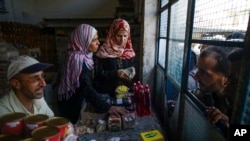On a scorching afternoon in the Syrian city of Deir el-Zour, two dozen people patiently line up at Rashid Izghair's shop, which only opened a few days earlier, to get the most basic of supplies: milk, pasta and canned food - items they had been deprived of for nearly three years.
Government forces broke a nearly three-year siege of Syria's largest eastern city earlier this month in a major offensive against the Islamic State group. Now, tens of thousands of residents such as these can go out and buy food.
Dozens of trucks carrying food, medicine and fuel have been arriving in the city, which had been under tight siege by the extremists, though much more is still needed.
"During those years our families who lived under the siege did not eat fruit or vegetables," said Mohammed Ibrahim Samra, Deir el-Zour's mayor. "IS terrorists blocked all the roads leading into the city and cut off all infrastructure. We had no electricity, no gas or fuel all this time."
Deir el-Zour is rising from the ashes, even as rounds of machine-gun fire can still be heard on the outskirts of town as Syrian government troops push out the remaining IS fighters. Government forces now control about two-thirds of the city while parts of the center and east are still dominated by extremists.
Late on Friday, fighting was ongoing outside the city as Syrian troops captured new areas along the west bank of the river including the town of Ayash.
Forces loyal to President Bashar Assad have been capturing areas around the country under the cover of Russian airstrikes since Moscow joined the war in September 2015. Breaking the siege of Deir el-Zour was Assad's biggest victory since December when his forces captured eastern neighborhoods of the northern city of Aleppo, Syria's largest and once commercial center.
The aim of the government appears to be to reach the border with Iraq to the east - which would boost Iran's influence in the region - as Iraqi forces gain ground on the other side of the border against the extremists.
Russia and Iran have been Assad's main backers since the conflict began in March 2011 with anti-government protests and later morphed into an all-out war. It is still not clear whether Syrian troops will be able to achieve their goal of reaching the Iraqi border on the northern parts of Deir el-Zour as U.S.-backed fighters are marching on the eastern side of the Euphrates River under the cover of airstrikes by the U.S.-led coalition.
Deir el-Zour province is the last main stronghold of the Islamic State group, which controls towns and villages along the Euphrates all the way to the Iraqi border town of Qaim.
Dismantling the siege at Deir el-Zour on Sept. 5 brought relief to tens of thousands of civilians trapped in four government-controlled neighborhoods and a nearby air base that had been surrounded by the extremists from all sides since January 2015. The Syrian government estimates about 70,000 people have survived on erratic air drops of food and supplies during the siege.
In the first visit by foreign journalists to the city, an Associated Press reporter traveled to Deir el-Zour on Friday on a trip organized by the Russian Defense Ministry.
The streets of the capital of this oil-rich eastern province that carries the same name looked deserted Friday afternoon with Syrian troops patrolling the area. Because of fuel shortages, cars are a rare sight, and machine-gun fire is audible in many neighborhoods, a reminder of just how close the IS fighters still are.
On Friday, IS positions were just half a kilometer (500 yards) away from the city cemetery on Deir el-Zour's western outskirts. An AP reporter saw a mortar land nearby and heard machine-gun fire at the city's cemetery, which was the frontline between IS and government troops just 10 days earlier. Most of the tombstones lay around toppled and smashed as IS fighters dug up the area to make fortifications.
Some neighborhoods looked completely abandoned, with weeds growing through the pavement near residential buildings in what was once an upscale neighborhood where roads are barricaded with piles of dirt to prevent possible IS suicide attacks.
The siege turned even basic food or goods into a luxury. Residents had to subsist on air drops delivered by international organizations and the Syrian government. The hospital's chief doctor Khalil Alsan said fuel shortages were so severe the ambulance service had to be shut down.
But now, the city and its residents - traumatized by the lengthy siege - are slowly coming back to life.
A market sprang up in the city center where locals sell second-hand goods or the scarce produce they grew in their yards off picnic tables or in makeshift tents made from metal rods and tarpaulin. On a recent day, shoppers stopped by to drink lemonade and eat falafel; elderly men play cards on the street.
A few blocks away, two dozen people lined up at Izghair's tiny grocery store. He said practically all of the city's shops were closed during the siege because owners simply had no supplies to sell.
Izghair's two female employees dispensed the shop's scarce selection of goods - milk, pasta, canned food and detergent - to customers who anxiously peeked into a small glass window of the store.
A man standing outside the shop, waiting for his turn to buy, took note of even these modest offerings.
"We had nothing before. Now there is aid that is distributed for free and there is also stuff in shops," he said.






